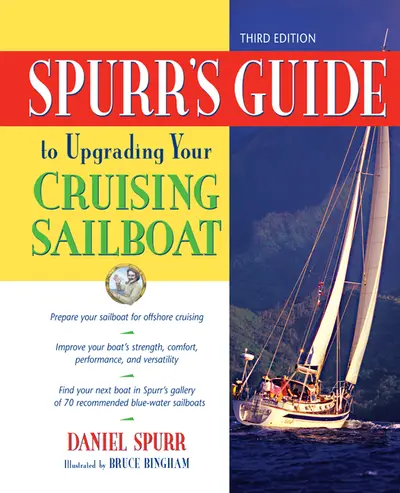My Account Details

ISBN10: 0071455361 | ISBN13: 9780071455367

Step 1 . Download Adobe Digital Editions to your PC or Mac desktop/laptop.
Step 2. Register and authorize your Adobe ID (optional). To access your eBook on multiple devices, first create an Adobe ID at account.adobe.com. Then, open Adobe Digital Editions, go to the Help menu, and select "Authorize Computer" to link your Adobe ID.
Step 3. Open Your eBook. Use Adobe Digital Editions to open the file. If the eBook doesn’t open, contact customer service for assistance.
Is your boat ready to go cruising? Just about every sailboat—used and new—can make a good cruiser, but only if the hull-deck structure, rig, and systems meet certain standards. Spurr’s Guide to Upgrading Your Cruising Sailboat tells you what those standards are, and gives you all the help you need to refurbish and upgrade every structure, surface, fitting, and system on your boat—stem to stern, project by project. This all-in-one guide leads you step by step to a seaworthy, crew-friendly boat with top-notch cruising performance. Not only will you learn what to look for when you buy a new or used boat, you'll also learn how to reinforce your boat’s hull and structural components, redesign and replace rigging, upgrade electrical systems, and much more. Special features include: A detailed survey of 70 used and new fiberglass sailboats best suited to offshore sailing Gear and equipment recommendations by brand name Construction details and other essential features of a strong, safe cruising boat How to make critical repairs to the deck, hull, bulkheads, blisters, and portlights
Acknowledgments
Introduction to the Third Edition
Chapter 1 The Anatomy of a Cruising Sailboat
The Cruising Imperatives; Design and Construction Considerations; Limit of Positive Stability; Multihulls; Hull Material; Rigs; Choosing a Boat; Further Reading
Chapter 2 Strengthening Major Structural Components
Identifying Weak Areas; Glass Fibers; Resins; Core Materials; Mold Release Agents; Distributing Stress; Health; Deck Reinforcements; Hull Flex; Hull-Deck Joints; Compression of the Deck at the Mast Step; Chainplates; External Reinforcements; Why I Hate Inner Liners; Reinforcing Rudders; Further Reading
Chapter 3 A Seagoing Interior Layout
Typical Production Boat Layout; My Ideal Layout; Berths; Stowage; Head; Converting V-Berths to a Double Berth; Installing a Sink and Mirror in a Hanging Locker; Installing a Through-Hull Toilet; Installing a Top-Loading Icebox; Installing a Removable Table; Adding Bookshelves and Extra Storage Space; Recovering All Cushions; Replacing Curtains and Rods; Relocating Stoves; For Comfort and Safety; Disaster Checklist; Further Reading
Chapter 4 Installing and Maintaining Seacocks
Types of Sea Valves; The Trouble with Gate Valves; Installing Seacocks; Electrical Bonding; Maintenance and Operation; Further Reading
Chapter 5 Basic Plumbing
Tanks; Piping; Pumps; Freshwater Systems; Watermakers; Seawater Systems; Odds and Ends; Installing Pumps; Pump Maintenance; Further Reading
Chapter 6 Steering Systems
Tiller Steering; Cable Steering; Hydraulic Steering; Worm Gear; Rack and Pinion; Installation; Autopilot Adaptations; Emergency Steering Systems; Making an Emergency Rudder; Wind Vane Auxiliary Rudders; Weak Links in the Steering System; Further Reading
Chapter 7 Self-Steering Systems
Autopilots versus Wind Vanes; Above-Deck Autopilots; Tiller-Mounted Autopilots; Below-Deck Autopilots; Wind Vanes; Wind Vane Adjustments; Self-Steering Expectations; Buying a Wind Vane; Further Reading
Chapter 8 Repowering
Gasoline Engines; Emergence of the Small Diesel; Going Engineless; Repowering; How Many Horses?; Fuel Capacity; Propeller Selection; Filters; Nonelectric Starters; Cutless Bearings/Stuffing Boxes; Sound Insulation; Further Reading
Chapter 9 An Efficient Deck Layout
Bowsprits, Platforms, Pulpits; Anchor Wells, Chainpipes, and Windlasses; A Complete Ground Tackle System; Lifelines, Stanchions, and Safety Lines; Requirements of a Seaworthy Companionway; Cleats; Mast Pulpits; Propane Tanks; Water Fills and Rain Catchments; Deck Drains; Making a Sea Hood; Cockpits; Life Rafts, Man-Overboard Poles, and Other Safety Equipment; Lights; Boom Gallows; Arches; Storm Shutters; Bulwarks; Protected Helm; Further Reading
Chapter 10 Rigs and Sails
Types of Rigs; Spars; Spinnaker Handling Systems; Going Aloft; Standing Rigging; Inspecting Rigging; Running Rigging; Sails; Winches; Halyards, Cleats, and Clutches; Further Reading
Chapter 11 Galley Systems
Requirements of a Good Galley; Types of Fuel; Installing an LPG System; Refrigeration; Contemplating Changes; Further Reading
Chapter 12 Generating Electrical Power
Batteries; Measuring Electricity; Engine Alternators; Regulators; Making AC with Inverters and Fuel-Powered Generators; Water-Driven Generators; Wind-Driven Generators; Solar; Installation; Further Reading
Chapter 13 Instruments and the Electrical System
Navigation Instruments; Marine Radiotelephones; How Much Do You Really Need?; Electrical Bonding; Lightning Ground Protection; Some Basics About 12-Volt DC Electrical Systems; Installing Shore Power; Further Reading
Chapter 14 Beating the Heat and Cold
Air Conditioning; Heating; Simpler Solutions; Ventilation; Deck Prisms; Further Reading
Chapter 15 Painti
Need support? We're here to help - Get real-world support and resources every step of the way.